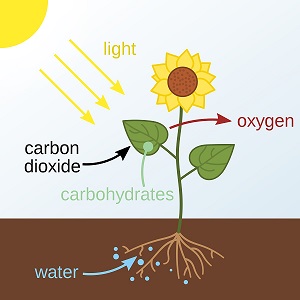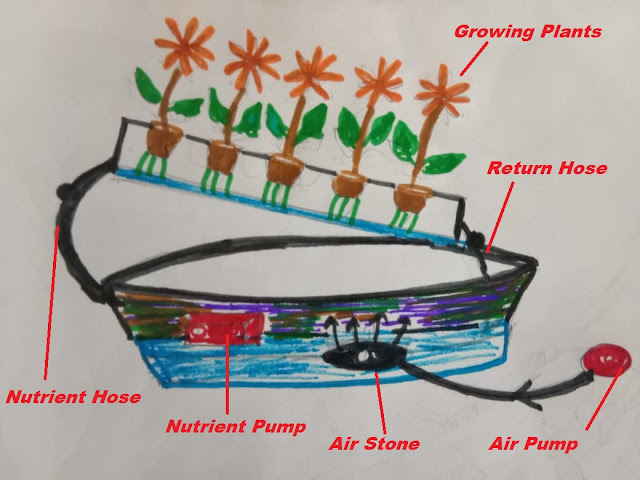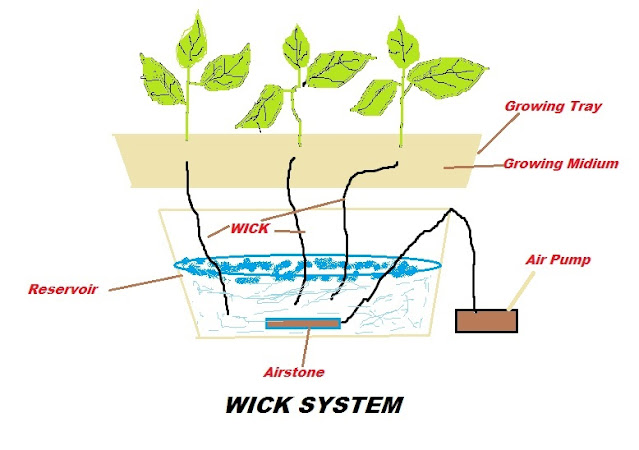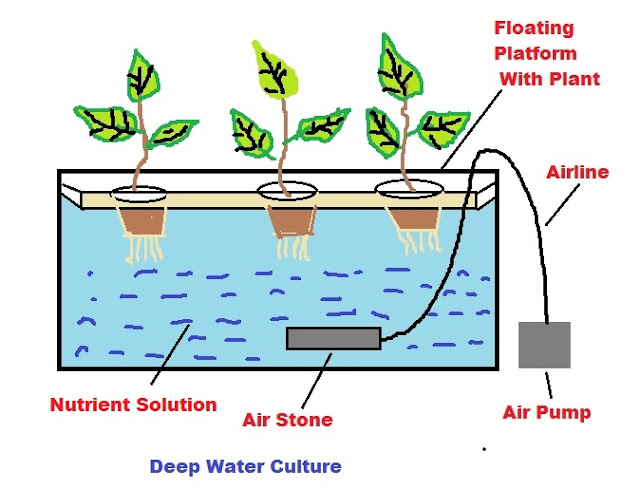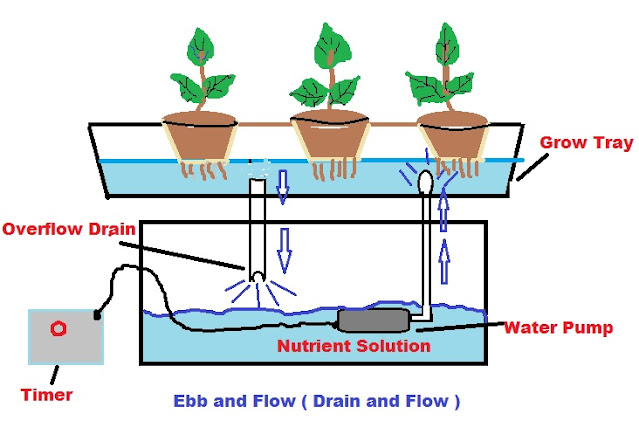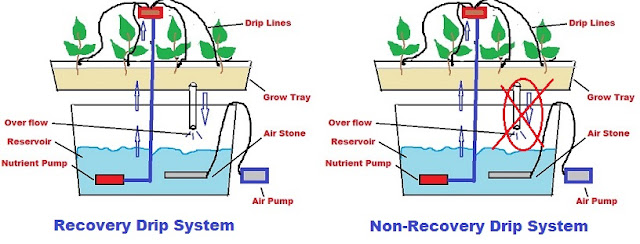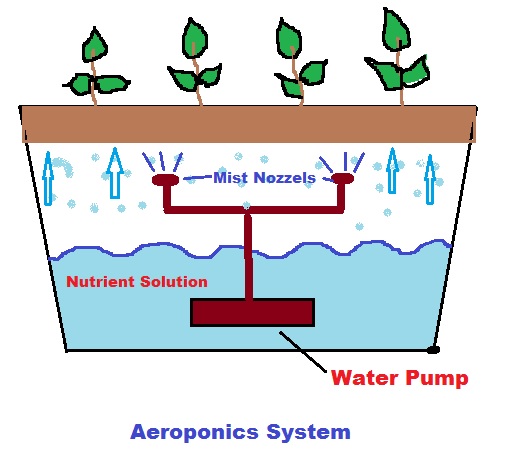Introduction to Hydroponics; Complete Information Guide
Introduction to Hydroponics; Complete Information Guide
The growth of a plant occurs due to a chemical reaction that takes place inside the leaves called chlorophyll in which it converts carbon dioxide and water into glucose and oxygen and this whole chemical process is known as photosynthesis which can be represented by the following equation –
6CO2 + 6H2O → C6H12O6 + 6O2
From the above equation, it is quite clear that soil has no role in the growth and development of a plant The role of soil is only to supply water and nutrient that are required for plant growth (which is already is present in the soil ) But if we can supply it through some nutrient-rich solution with the help of root under these condition plant can be grown without the soil very easily and this is the basic principle of the hydroponics. Hence we can define hydroponics as a methodology for growing plants without soil in a nutrient-rich solution.
How Does Hydroponics Work?
The crops that can be grown in Hydroponic Systems
Although practically any crop harvest can be taken hydroponically, the most well-known are; leaf lettuce, tomatoes, peppers, cucumbers, strawberries, watercress, celery, and a few spices. One of the key factors in hydroponic farming is the framework plan for a specific harvest is the manner by which it is upheld in the supplement arrangement.
Advantages of Hydroponic System ;
1) Zero Soil Involvement;
Hydroponic farming means growing crops without soil, it provides an opportunity for anyone who has a small piece of land or has no land. In recent years, Hydroponic is frequently considered as the cultivating technique for the future as a few space travelers in NASA have thought about it as an opportunity for developing harvests in space.
2) Saves Water;
In hydroponic Farming, the water and nutrient solution is automatically fed to the plants with the help of a closed circulation method. Due to this water consumption decreases up to 80-90% as compared to traditional crop cultivation in soil. It restricts the loss of water and nutrient which take place due to the process of leaching and surface evaporation. It is well suited for dry and extreme areas.
3) Independent from Season and weather ;
All the basic requirement of the plant is provided in a form of a duly maintained structured system due to which Hydroponic Farming can be grown anywhere. Like on the balcony of your apartment, the roof of the house, or even in your bedroom, etc. Whereas conventional farming practices require more space because the plant roots need to expand and thoroughly spread out in a bid to search for food and oxygen levels in the soil.
In the hydroponic system, the roots are already submerged in a tank of oxygenated solution that has direct contact with the vital minerals. That means multiple plants can be grown in close proximity without having too much worry about space. Plants can be grown Horizontally or vertically in rakes.
5) Hydroponics Reduces the workload;
Hydroponics systems are mostly automated, which means hydroponics reduces the workload as there is no requirement of soil handling, spraying of agrochemicals, irrigation, weeding, etc.
6) Hydroponics uses No Herbicides & fewer Pesticides;
In hydroponics farming the plants grow in controlled environmental conditions and, they are less exposed to pests and almost free from weed growth. Therefore, herbicide application is not required and the use of pesticides is significantly reduced as compared to the cultivation in soil, also because the plants are significantly stronger and less exposed to environmental influences.
7) Hydroponics Farming Gives High Plant Yields
Hydroponic farming frameworks are ideal for indoor cultivating and metropolitan planting since they need less space. The hydroponic framework can enhance the crop yield up to four times in contrast to traditional cultivation practices but it depends upon the type of hydroponic system that is in use This has a space-saving impact on the developed region.
8) Access to the roots
under a hydroponic system growing crops’ roots are clearly visible as there are no soil particles found around the plant roots hence access to the root system is very easy due to which plant diseases can easily recognize at earlier stages as they are important in many medicinal plants.
Like greenhouses, hydroponic growers have absolute control over climatic conditions. Growers can adjust the temperature, Light intensity, and humidity levels as per their requirements.
Hence, By adopting Hydroponic Farming you can continue the cultivation of crops all year round without having to worry about the season. This is additionally prone to help the business benefits of ranchers
10) Optimal Use of Nutrients;
In Hydroponics Systems there is total control over the nutrients supply to the plants in accordance with their specific requirement. Even before starting farming, you can prepare a schedule that what kind of nutrients are required by the plant, and then a nutrient mixture of particular amounts of those nutrients with water at different stages can be easily prepared. Since the supplements are appropriately monitored in tanks, there is no chance of supplement misfortune.
11) pH control
As minerals are directly in touch with water, The pH level of the growing medium can be manually controlled as per requirement and this will ensure that the plants receive optimal nutrient intake.
12) Faster Growth Rate
The hydroponic system ensures a faster growth rate due to control over the environment required for the plants’ growth.
It ensures specific control over parameters like temperature, light intensity, moisture, and most importantly, nutrients. Along these lines, plants will not waste their important energy searching for weakened supplements lowered profound inside the dirt; rather, they can primarily be centered around flourishing and boosting the creation of organic products.
Disadvantages of hydroponics
2) Hydroponics is usually less forgiving than soil-based agriculture (so mistakes are magnified).
4) It takes more resources to put together a hydroponic system (often requiring pumps, plastic containers, draining systems, and fertilizer-adding mechanisms).
5) In some ways hydroponics is more labor-intensive (individual plants are often pruned more, and many machines made for large-scale industry-such as combines do not have a commonly-used equivalent in hydroponic production). Compared to large field-scale agriculture, hydroponics may be more labor-intensive.
6) Although farming at a large scale with either soil-based or hydroponic production is quite technical and requires a lot of knowledge & experience, I think it is easier to begin (at the dabbling stage) with soil-based agriculture.
7) Hydroponics, in some circles has a bad name. It is sometimes considered more unnatural than soil-based farming (having a lot of experience with both, I would strongly contend that neither is natural). In other circles, it is considered a euphemism for growing marijuana (which is probably a benefit in some groups).
8)If you have a lot of inexpensive arable land, soil-based farming may be more efficient.
Many innovative systems are developed that replace the standard gravel-filled bed. once evaluating the kind of system to put in, thought ought to run to such factors because of the kind of crop grownup, the area needs, growing time, network, and economics.
These frameworks can be set up in either a nursery or development room. A few cultivators utilize both; the development space for germination and seedling creation and the nursery to develop out the yield. The additional warmth from the development room lights might be utilized to warm the nursery. The most common type types of Hydroponic system used are as follows;
1) Wick System Sand/stone culture
The Wick system is mostly used to grow plants that require almost no maintenance and low nutrients. The Wick system is best suited for growing leafy vegetables hydroponically
2) Deep Water Culture (DWC);
Deep Water Culture systems are one of the simplest hydroponic systems among all types of hydroponic systems. These are very effective for growing plants hydroponically.
DWC system is preferred a lot by home hydroponic growers, as well as many commercial growers use this type of system on a large scale. DWC system is quite popular because of its simplicity and easy concept. It’s also a very inexpensive type of system to install. Even though the concept is simple, there are a lot of imaginative ways to use and construct water culture systems out of different available materials.
3)Ebb and Flow ( Drain and Flow );
This is a system of hydroponically growing plants that circulate water, nutrients, and oxygen to the roots of plants in periodic cycles that consist of flooding the growing medium with water-based nutrient solution and then draining the liquid and allowing the medium to dry out.
The basic principle behind the system is that intermittent flooding occurs in cycles that allow the growing medium to dry out between them. This short dry period is beneficial to the growing plants because it allows their roots to grow in search of moisture and due to which the plant’s root system gets developed in a better way and in result it enhances the absorption of nutrients finally that result in faster and healthier growth of the plants
4) Drip System Recovery / Non-Recovery
Presently Drip systems are a widely used hydroponic technique. In this system, a timer controls a water pump, which pumps water and nutrient solutions through a network of elevated water jets. A recovery system will collect excess nutrient solution back into the reservoir.
5)Nutrient Film Technique(NFT) ;
NFT technique is one of the foremost well-liked systems employed in hydroponic systems during this system the nutrient resolution is incessantly flowing over the roots. this can be accomplished by exploiting gravity. The grow tray is placed at an associate angle to permit the water to flow down towards the drain, and a new solution is consistently pumped up into the high finish of the tube. NFT is an active system, which means it depends on moving components to work.
The nutrient solution flows through a thin film over the roots, guaranteeing that they’re watered and fed but not fully soaked. the thin film ensures that the higher part of the roots can stay dry and have access to oxygen in the air.
The nutrient Film Technique works best if you decide on plants that don’t need tons of support- lightweight, fast-growing plants that may be harvested quickly. If you wish to grow plants like tomatoes or squash, simply certify that you simply have the correct support systems in situ like trellises. The roots aren’t suspended during a growing medium during this system, in order that they cannot handle supporting a lot of weight from an unstable plant.
The main elements of an NFT system are similar to Ebb and Flow—the distinction is their configuration.
6) Aeroponics ;
Other components;



